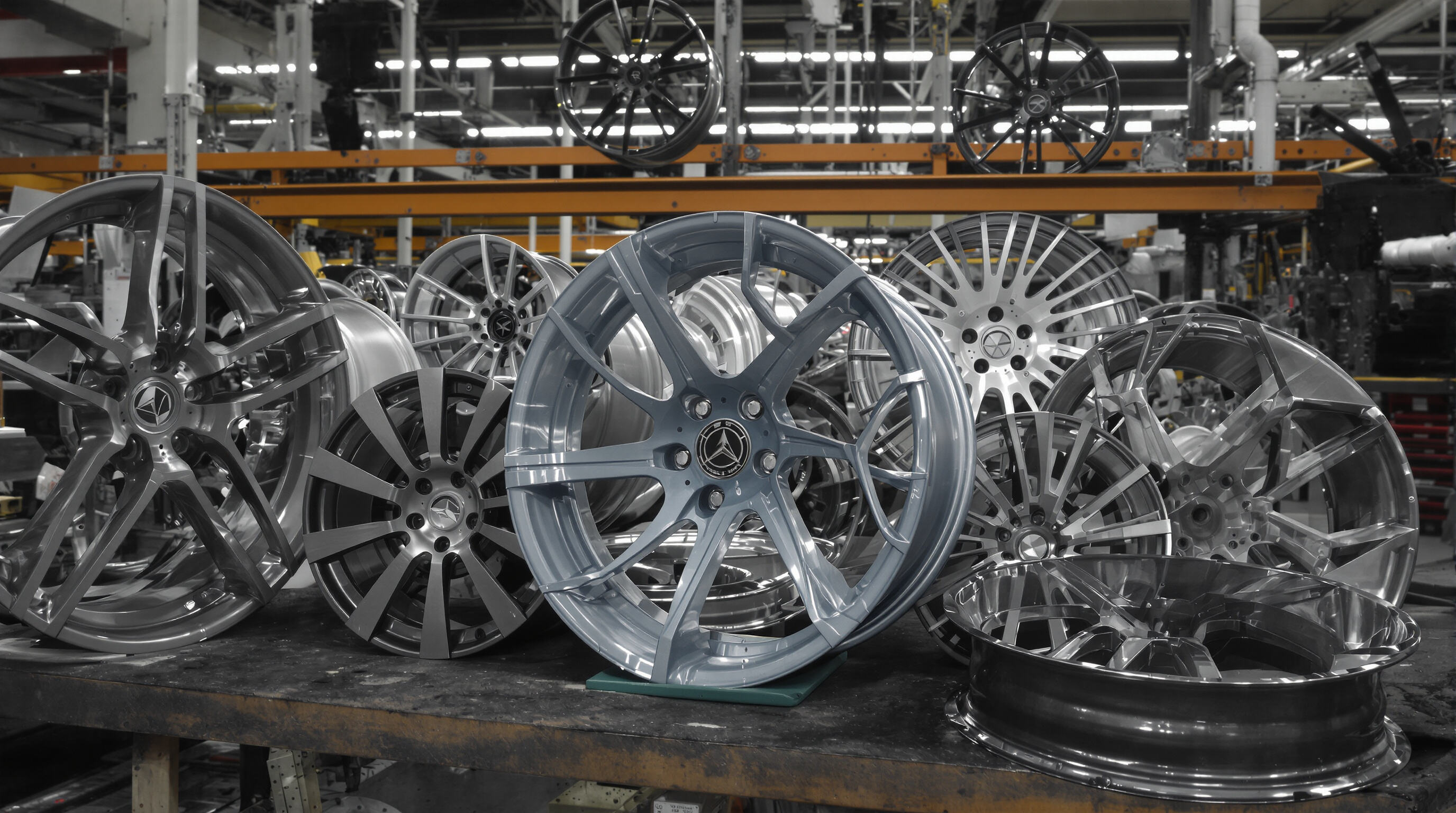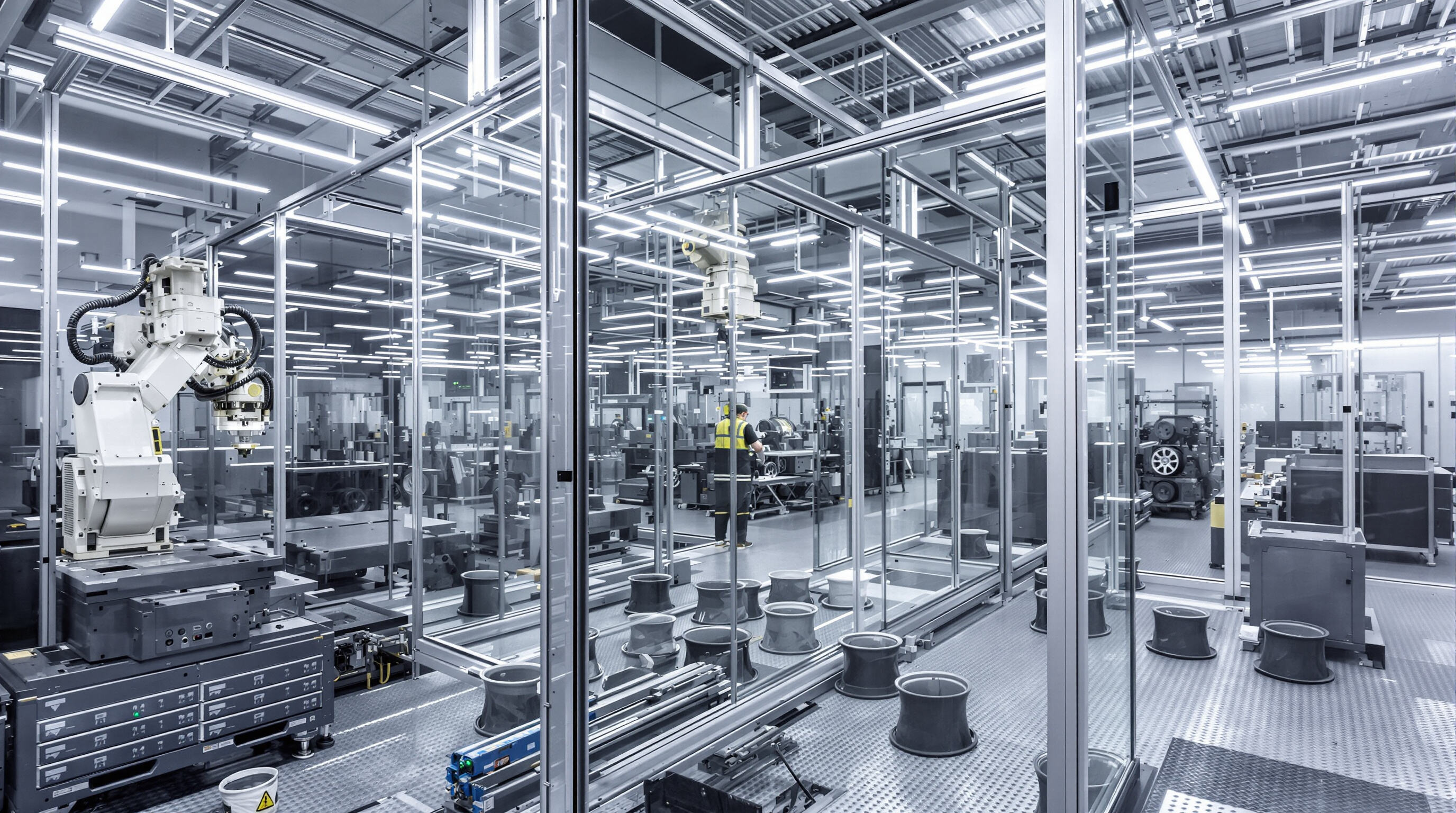
Automobiļu rūpniecības tieksme uz vieglākiem transportlīdzekļiem ir pārdefinējusi riteņu ražotājs prioritātes. Saskaņā ar ASV Enerģētikas departamentu, 10% vieglāks transportlīdzeklis uzlabo degvielas ekonomiju par 6–8%. Tas liek fabrikām pieņemt materiālus, piemēram, kaltu alumīniju un oglekļa šķiedru armētus polimērus, kas apvieno izturību ar ievērojamu masas samazināšanos.
Oglekļa šķiedras riteņi tagad sver par 40–50 % mazāk nekā tradicionālie alumīnija riteņi. Ražotāji izmanto sveķu pārlejšanas formēšanu, lai izveidotu sarežģītas, dobas sķēres dizainus, kas saglabā strukturālu integritāti. Kompozīta pamatnes, piemēram, bazalta šķiedras hibrīdi, parādās kā izmaksu ziņā efektīvas alternatīvas, lai veicinātu plašāku tirgus pieņemšanu.
Nesaspiesta svara—masas zem transportlīdzekļa suspensijas—samazināšana uzlabo vadāmību, paātrināšanos un bremzēšanu. Vieglie riteņi var samazināt bremzēšanas attālumu par 5–7 % un uzlabot stūrēšanas stabilitāti. Elektromobiļiem rotācijas inerces samazināšana tieši palielina izbraukšanas attālumu, uzlabojot enerģijas efektivitāti.
| Materiāls | Svara samazināšana | Izmakas vienam ratam | Izturība (1–10) |
|---|---|---|---|
| Tērauds | 0% | $120 | 9 |
| Aluminija alejancija | 25% | $300 | 8 |
| Ogļvielas plāksne | 48% | $1,200 | 7.5 |
Kaut arī tērauds joprojām ir izdevīgs un izturīgs, kompozitie materiāli nodrošina neaizvietojamu svara samazinājumu. Alumīnija sakausējumi piedāvā līdzsvaru, taču riteņu ražotnes aizvien biežāk izvēlas oglekļa šķiedru augstas veiktspējas elektriskajiem auto, kas vērsti uz aerodinamikas un efektivitātes uzlabošanu.
Elektriskajiem automobiļiem ir šī iezīme, ka torsi tiek piegādāts uzreiz, kas nozīmē, ka riteņiem jāiztur lielāka slodze, tomēr saglabājot rotācijas vieglumu. Šodien ražotāji sāk pāriet uz riteņu izgatavošanu no oglekļa šķiedras. Saskaņā ar dažām tirgus analīzes atskaitēm no 2025. gada, gandrīz trīs ceturtdaļas no jaunajām iekārtām, kas specializējas uz EV, tagad strādā ar kompozītmateriāliem, nevis ar tradicionālām metodēm. Salīdzinot ar parastajiem alumīnija riteņiem, šie oglekļa riteņi faktiski samazina nesaspiesto masu par aptuveni 38 procentiem. Tas ir svarīgi, jo vieglāki riteņi uzlabo rekuperatīvā bremzēšanas efektivitāti, ļaujot automašīnām atgūt vairāk enerģijas bremzēšanas laikā. Tāpēc uzņēmumi steidzas pieņemt šo tehnoloģisko pāreju.
Katra 10% riteņu masas samazināšana pagarina BEV (elektromobila) darbības rādiusu par 6–8 jūdzēm, tādējādi kompozītmateriālus padarot par būtisku sastāvdaļu, lai apmierinātu patērētāju gaidas. Automobiļu karbona riteņu tirgus līdz 2033. gadam prognozēts pieaugt 1,7 reizes, jo rūpnīcas ievieš nākamās paaudzes sveķu pārneses formēšanas tehnoloģijas, kas samazina ražošanas laiku par 50%.
2025. gada nozares analīze atklāja, ka luksusa klases BEV ar rūpnīcas uzstādītiem karbona riteņiem sasniedz 12% lielāku efektivitāti salīdzinājumā ar alumīnija riteņiem. Viena ražotāja ziņojumā teikts, ka, optimizējot karbona riteņu aerodinamiku, paātrinājums kļuvis 22% ātrāks un rezinēm nodilis par 19% mazāk, tādējādi apstiprinot tendenci pāriet uz BEV specifiskām riteņu inženierijas metodēm.

Šodien lielākā daļa riteņu ražotāju ir pārgājuši uz sveķu pārneses formēšanu (RTM), lai izgatavotu oglekļa šķiedras riteņus. Saskaņā ar pēdējo pētījumu, ko publicēja Materials Science Journal, šī metode nodrošina detaļas ar apmēram 30% mazāk tukšumiem salīdzinājumā ar vecajām avtoklavas tehnikām. Kas padara RTM tik pievilcīgu? Nu, tā darbojas, injicējot epoksīda sveķus jau veidotās oglekļa slāņos, pielietojot tieši pareizo spiediena daudzumu. Tas nodrošina riteņus, kuru svars ir apmēram par 40 līdz 50 procentiem mazāks nekā to alumīnija analogiem. Ir vēl viena priekšrocība. Saskaņā ar pērn publicētiem datiem, ko sniedza Global Wheel Manufacturing Report, uzņēmumiem, kas izmanto RTM, pēc ražošanas ir vajadzīgi apmēram par 60% mazāk mašīnbūves darbiem, kas samazina enerģijas izmaksas par aptuveni 18,7 ASV dolāriem uz vienu izgatavoto vienību. Skaidrs, kāpēc šodien daudzas rūpnīcas veic pārslēgšanos.
AI darbināti redzes sistēmas analizē 8000 datu punktus katrā ritenī lejot, samazinot defektus par 22% (Advanced Manufacturing Quarterly 2024). Mašīnmācīšanās algoritmi reāllaikā pielāgo lejšanas temperatūru un dzesēšanas ātrumu, uzlabojot materiāla iznākumu par 15% un ļaujot pārkonfigurēt 90 sekundēs, kad tiek konstatētas siltuma nekonsekvences.
Digitālo divnieku tehnoloģija ir saīsinājusi riteņu prototipa izstrādes laiku no 18 līdz 6,5 nedēļām. Inženieri simulē stresa testus vairāk nekā 200 slodzes scenāriju apstākļos pirms fiziskas ražošanas, identificējot 92% iespējamo atteikšanās punktu virtuālās validācijas laikā (Automotive Engineering Today 2024).
Lai gan progresīva ražošana prasa par 35–40% lielāku sākotnējo ieguldījumu, tā nodrošina par 62% zemākas vienības izmaksas apjomā. 2025. gada cikla analīze parāda, ka rūpnīcas šīs izmaksas atgūst 3,2 gados caur 740 000 USD ikgadējiem ietaupījumiem enerģijas un materiālu atkritumos (Ilgtspējīgas ražošanas apskats 2025).
Ratu ražotāji šodien paļaujas uz sarežģītiem rīkiem, piemēram, kā šķidruma dinamikas aprēķinus (CFD) un faktiskus vēja tuneļu testus, lai precīzi izveidotu ratus, kas efektīvi pārgriež gaisu. Šāds pieeja var samazināt vēja pretestību par 15–20%, salīdzinot ar vecāku tipa spieķiem. Tā pati tehnoloģija ļauj inženieriem samazināt svaru par aptuveni 7%, saglabājot struktūras integritāti. Zemāks pretestības līmenis ir ļoti svarīgs elektriskajiem transportlīdzekļiem, jo tas tieši ietekmē baterijas darbības laiku starp uzlādēšanām. Arī uzlabotās dizaina formas arvien biežāk sastopamas augstas klases automašīnās no zīmoliem, piemēram, Tesla, BMW un Mercedes, kuri vēlas maksimāli palielināt efektivitāti, nezaudējot veiktspēju.
Riteņu mijiedarbība ar gaisu ietekmē ripošanas pretestību, kas patērē apmēram 20 līdz 30 procentus no kopējā automašīnām šodien izmantotā enerģijas daudzuma. Strādājot ar gaisu, plūsmas riteņi ar minimāliem spraugām spēj samazināt šos nevēlamos gaisa virpuļus, kas reāli uzlabo degvielas patēriņu tradicionālajiem dzinējiem (apmēram par 4 līdz 6 procentiem) un nodrošina elektriskajām mašīnām papildu 12 līdz 15 jūdžu attālumu uz vienu uzlādi. Pagājušajā gadā publicēti pētījumi parādīja, ka, pareizi pielāgojot riteņu formu, riepas deformējas mazāk un izraisa mazāku siltuma veidošanos, kas nozīmē lielāku enerģijas saglabāšanos. Ražotāji jau sākuši izmantot šos datus ražošanas līnijās, apvienojot estētiku ar funkcionalitāti, mainot mūsu gaidas par modernām automašīnām un izvirzot jaunus efektivitātes standartus automobiļu nozarē.
Pasaules ratu ražošanas nozare, šķiet, ir iestājusies uz ievērojamu izaugsmi, ar aprēķiniem, kas liecina par aptuveni 6,4% gadu gaitā no 2025. līdz 2032. gadam. Šāda augšupejoša tendence ir saprotama, ņemot vērā, ka gan elektrisko, gan tradicionālo automašīnu ražotāji aizvien vairāk meklē vieglākus materiālus. Uz priekšu skatoties, eksperti domā, ka oglekļa šķiedras ratu tirgus varētu sasniegt apmēram 600 miljonus USD līdz 2028. gadam. Kāpēc? Nu, valdības pastāvīgi savelk emisiju noteikumus, un automašīnu uzņēmumiem ļoti gribas padarīt savas mašīnas efektīvākas. Saskaņā ar pērn publicētiem pētījumiem, lielākā daļa automobiļu ražotāju šobrīd iztērē vairāk nekā divas trešdaļas no saviem līdzekļiem jaunām izstrādēm, lai samazinātu transportlīdzekļu svaru, izmantojot labākus materiālus.
Ražotāji visā pasaulē sāk izmantot slēgto ciklu otrreizējai pārstrādei ar oglekļa šķiedru atkritumiem. Dažas uzņēmējsabiedrības apgalvo, ka tās patiesībā var atgūt apmēram 90 procentus no saviem atkritumiem un tos atkal izmantot ražošanā, kas nozīmē, ka poligonos nonāk par 40 procentiem mazāk materiālu nekā 2020. gadā. Apskatot sveķu izmantošanu, aptuveni trešā daļa uzņēmumu nesen ir pārgājusi uz bioloģiski bāzētiem variantiem. Šāda pārmaiņa palīdz samazināt letargisku organisko savienojumu emisijas par 50 līdz 60 procentiem, nezaudējot produktu kvalitāti. Šie skaitļi atbilst nozares pētījuma ziņojam, kas tika publicēts pagājušajā gadā (2024), kurā tika norādīts, ka ražošanas procesu pārveidošana uz zaļo enerģiju varētu samazināt oglekļa pēdas lielumu visā piegādes ķēdē par aptuveni 22 procentiem katram izstrādājumam.
Viegli materiāli ir kritiski svarīgi, jo tie samazina transportlīdzekļa svaru, uzlabo degvielas ekonomiju, uzlabo vadāmību un palielina enerģijas efektivitāti, īpaši elektriskajiem transportlīdzekļiem.
Oglekļa šķiedras riteņi ir ievērojami vieglāki, kas uzlabo transportlīdzekļa veiktspēju paātrināšanās, bremzēšanas, stūrēšanas stabilitātes un enerģijas efektivitātes ziņā.
Samazināta nesasprindzinātā svara EV nodrošina labāku vadāmību, uzlabo bremzēšanas efektivitāti, pagarina darbības diapazonu un uzlabo rekuperatīvās bremzēšanas iespējas.
Izplatītie materiāli ir tērauds, alumīnija sakausējumi un oglekļa šķiedra. Tērauds ir izturīgs un izmaksu ziņā izdevīgs, savukārt oglekļa šķiedra nodrošina lielisku svara ietaupījumu un veiktspējas priekšrocības.